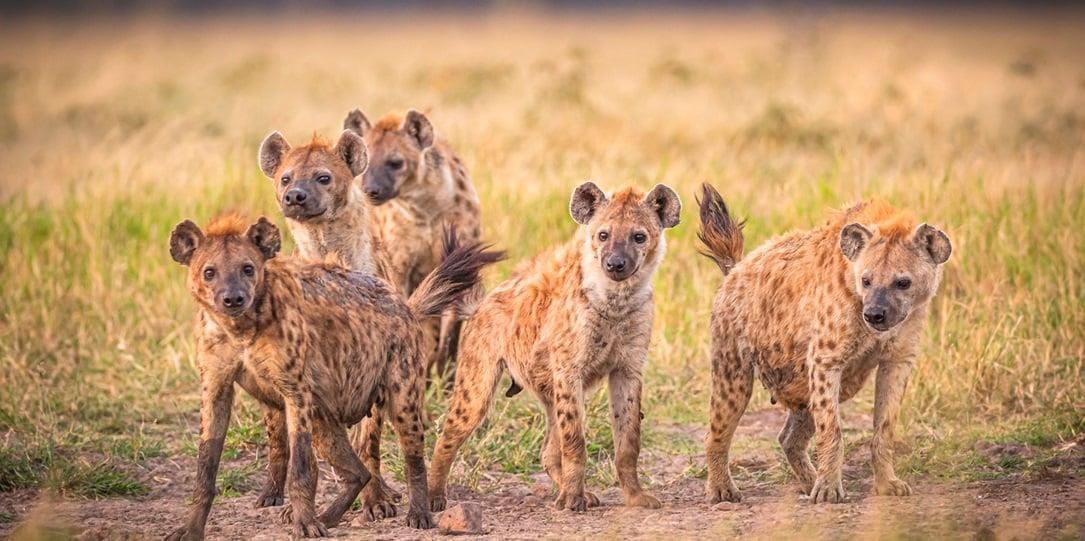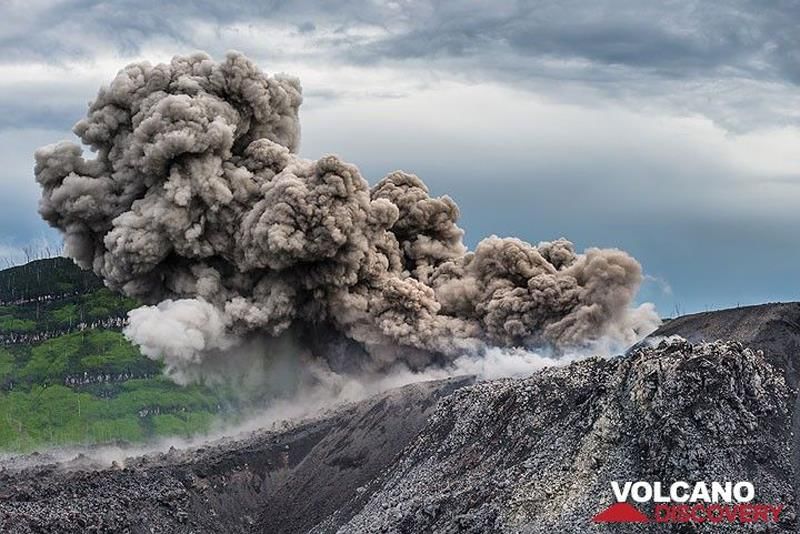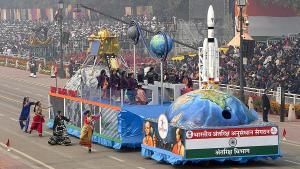UPSC Daily Current Affairs: 23rd January 2025 | Current Affairs & Hindu Analysis: Daily, Weekly & Monthly PDF Download
GS3/Environment
Spotted Hyena: Recent Observations in Southern Egypt
Source: DTE
 Why in News?
Why in News?
Recent research conducted by Egyptian scientists has revealed the reappearance of the spotted hyena (Crocutta crocutta) in southern Egypt after an absence of 5,000 years, prompting discussions on possible environmental changes affecting its range.
- The spotted hyena is one of Africa's most abundant carnivorous species.
- This species exhibits a unique matriarchal social structure, living in groups called clans.
Additional Details
- Spotted Hyena: Also known as the laughing hyena, this intelligent animal is recognized for its complex social behavior. It is a strong predator and scavenger, making it the largest member of the hyena family.
- Nocturnal Behavior: Spotted hyenas are primarily active at night, utilizing their excellent night vision to hunt.
- Physical Characteristics: They have a sandy, yellowish or gray coat adorned with black or dark brown spots, which tend to be more pronounced in younger individuals.
- Habitat: Spotted hyenas thrive in a range of open dry habitats, including semi-deserts, savannahs, and acacia bush mountainous forests.
- Distribution: This species is commonly found throughout sub-Saharan Africa.
- Conservation Status: According to the IUCN, the spotted hyena is classified as Least Concern, indicating it is not currently at significant risk of extinction.
The reappearance of the spotted hyena in Egypt raises intriguing questions about how environmental factors, such as climate change, may be influencing its habitat range and population dynamics.
GS3/Science and Technology
Stargardt Disease and Gene Editing Advances
Source: Nature
Why in News?
Researchers from Switzerland have made significant strides in developing a gene editing technique that may provide a potential treatment for Stargardt disease, a hereditary condition leading to vision loss.
- Stargardt Disease: Also known as Stargardt macular degeneration, primarily caused by mutations in the ABCA4 gene.
- Symptoms: The disease leads to progressive loss of central vision, often beginning in childhood or young adulthood.
- Prevalence: Estimated to affect 1 in 8000 to 10,000 individuals, with a higher incidence in males.
- Treatment: Currently, there is no cure for Stargardt disease.
Additional Details
- Genetic Basis: The ABCA4 gene plays a crucial role in the metabolism of Vitamin A, and its dysfunction results in an accumulation of lipofuscin in the retina.
- Symptoms: Common symptoms include a gradual loss of central vision, the appearance of gray or hazy spots in vision, sensitivity to light, and instances of color blindness.
- Impact on Vision: The accumulation of lipofuscin affects the macula, which is responsible for sharp central vision, leading to significant visual impairment.
- Legal Blindness: Many individuals with Stargardt disease may experience deterioration of visual acuity, potentially resulting in legal blindness.
Despite the absence of a cure for Stargardt disease, ongoing research into gene editing holds promise for future treatment options that could restore or improve vision for affected individuals.
GS3/Economy
China’s Moves Must Recast India’s Critical Minerals Push
Source: The Hindu
 Why in News?
Why in News?
In the context of shifting geopolitical dynamics, critical minerals have become central to international economic diplomacy. These resources are crucial for various advanced technologies, which positions them at the heart of global strategic competition. Recent actions by China have intensified the focus on these minerals, presenting both challenges and opportunities for countries like India.
- China has expanded its export controls, affecting key minerals critical for high-tech industries.
- India faces challenges in developing its domestic mineral market, including inadequate infrastructure and regulatory issues.
- Opportunities exist for India to enhance its mineral sector through strategic reforms and global alliances.
Additional Details
- China's Strategic Leverage: On January 2, 2025, China’s Ministry of Commerce added 28 U.S. entities to its export control list, limiting their access to essential minerals like tungsten, gallium, and lithium-6. This move illustrates China's strategy of using critical minerals as leverage against geopolitical rivals.
- India’s Domestic Challenges: India’s mineral exploration infrastructure is underdeveloped, with many potential sites classified as G3 or G4, creating uncertainty for investors. Additionally, the auction process for mineral blocks has seen limited interest due to policy ambiguities and an unattractive risk-reward ratio.
- Dependence on Imports: Despite efforts to boost domestic production, India remains significantly reliant on imports for critical minerals, exposing it to geopolitical risks and hindering its industrial growth.
- Opportunities for Growth: India possesses substantial untapped mineral potential, as evidenced by recent lithium discoveries. Policy reforms, such as those introduced by the Mines and Minerals (Development and Regulation) Amendment Act, 2023, aim to attract both private and foreign investment.
- Fiscal Incentives: The introduction of exploration licenses and a promise of reimbursement for exploration costs are designed to stimulate investment. However, outdated resource classification systems still impede progress.
In conclusion, India's critical minerals sector is at a pivotal point, where addressing its current challenges can unlock significant economic opportunities. By improving geological data access, offering fiscal incentives, and fostering international partnerships, India can position itself as a key player in the global critical minerals market.
GS3/Environment
Chinar Tree: The Heritage of Kashmir
Source: Mint
Why in News?
The iconic Chinar trees of Kashmir have been digitally protected through geo-tagging and the attachment of QR codes, ensuring the preservation of this important element of the Valley's heritage.
- Scientific Name: Platanus orientalis
- Local Name: Boueen, named after the Hindu goddess Bhavani
- State Tree: Jammu and Kashmir
Additional Details
- Physical Characteristics: The Chinar tree is a large, deciduous tree that can grow up to 30 meters tall and has a girth of 10 to 15 meters. It takes approximately 30 to 50 years to reach its mature height and up to 150 years to attain full size.
- Unique Properties: This species is the only member of the Platanaceae family found in India and is predominantly located throughout the Kashmir Valley. Its leaves exhibit seasonal color changes from deep green in summer to vibrant red, amber, and yellow in autumn.
- Uses: Various parts of the Chinar tree are utilized for medicinal purposes; its wood, known as lace wood, is prized for crafting delicate interior furniture, and its twigs and roots are used in dye production.
- Geo-tagging Initiative: The geo-tagging project, led by the J&K Forest Research Institute, involves attaching QR codes to each Chinar tree. This process records vital information such as geographical location, health, age, and growth patterns, allowing conservationists to monitor and manage the trees effectively.
- Age Confirmation: Recent geo-tagging efforts have revealed that many Chinar trees exceed the previously estimated age of 700 years, with some being over 1000 years old.
This digital protection initiative not only safeguards the Chinar trees but also enhances our understanding of their ecological significance and heritage value, ensuring that future generations can appreciate these magnificent trees.
GS2/Polity
National Voters’ Day
Source: The Hindu
Why in News?
The 15th National Voters’ Day (NVD) will be celebrated throughout India on January 25. This event marks the significance of voter participation in the democratic process and aims to enhance electoral awareness among the populace.
- National Voters’ Day has been observed annually since 2011.
- This day commemorates the foundation of the Election Commission of India, established on January 25, 1950.
- The day emphasizes the importance of voters and encourages their active involvement in elections.
- New voters, particularly the youth who have recently become eligible, are honored and presented with their Elector Photo Identity Card (EPIC) during the ceremonies.
Additional Details
- This Year’s Theme: “Nothing Like Voting, I Vote for Sure” - This theme continues from the previous year, focusing on the importance of participation in the electoral process and inspiring pride in exercising voting rights.
- National Voters’ Day serves to promote the enrollment of new voters and raise awareness about the electoral process, ensuring that citizens understand their rights and responsibilities.
In summary, National Voters’ Day plays a crucial role in fostering a vibrant democratic culture in India by recognizing the importance of each voter and encouraging participation in elections.
GS3/Defence & Security
It’s Russian Roulette in the Skies
Source: The Hindu
Why in News?
The issue of civilian aircraft being shot down, often arising from misidentification, poses a significant threat to aviation safety. This alarming trend necessitates a thorough examination of historical incidents, their causes, and the urgent need for global reforms to enhance air travel safety.
- Historical incidents reveal the dangers of misidentification in conflict zones.
- India's aviation challenges include navigational vulnerabilities, pilot training issues, and aging aircraft.
- Global cooperation and regulatory reforms are crucial to prevent civilian aircraft shoot-downs.
Additional Details
- Korean Airlines Flight 007: Shot down by a Russian fighter plane in 1983 due to navigational errors, killing all 269 people on board. This incident highlighted the geopolitical challenges in aviation safety reforms.
- DHL Cargo Plane Incident: On November 22, 2003, a DHL cargo flight was hit by a missile but managed a successful landing, demonstrating crew skill despite critical failures.
- Iran Air Flight 655: Mistakenly identified as a military threat by the USS Vincennes in 1988, leading to 290 civilian deaths, illustrating the catastrophic results of misidentification.
- Indian Air Force Mi-17 Helicopter: Shot down in 2019 due to misidentification during operations, highlighting the risks associated with flawed identification protocols.
- Contemporary Risks: The downing of Malaysia Airlines Flight MH17 in 2014 and an Azerbaijani airliner in 2024 underline ongoing threats from armed conflicts and miscalculations in air defense.
- Navigational Vulnerabilities: India's proximity to conflict zones raises concerns about GPS reliability and the need for alternative navigation systems.
- Pilot Training and Skill Proficiency: Accelerated training programs may compromise pilot readiness for modern aviation challenges.
- Aging Aircraft: Some Indian airlines operate older aircraft not equipped for demanding flight conditions, posing operational risks.
- Regulatory Gaps: The DGCA's lack of transparency and accountability raises concerns regarding its ability to enforce safety measures effectively.
In summary, the historical and ongoing challenges in aviation safety underscore the need for rigorous international cooperation and improved regulatory frameworks to ensure the safety of civilian flights in conflict-prone regions. The aviation industry must prioritize safety and preparedness to mitigate the risks posed by misidentification and procedural failures.
GS2/Governance
National Health Mission (NHM): Transforming Public Health in India
Source: PIB
Why in News?
The National Health Mission (NHM) has been pivotal in improving public health in India, contributing to the significant reduction of maternal mortality, tuberculosis (TB) cases, and sickle cell anemia. The Central Government highlighted these achievements in its assessment report for 2021-24, which was presented to the Union Cabinet on January 22, 2025.
- NHM aims to provide quality healthcare services to all citizens.
- It has evolved from the National Rural Health Mission (NRHM) and includes the National Urban Health Mission (NUHM).
- Significant reductions in maternal and child mortality rates have been achieved under NHM.
Additional Details
- Background: The NRHM was initiated in 2005 to enhance healthcare accessibility and affordability for rural populations. The NHM was established in 2012, incorporating both NRHM and NUHM.
- Goals:
- Ensure universal access to quality healthcare services.
- Provide affordable and equitable healthcare.
- Respond effectively to community health needs.
- Advance towards achieving Sustainable Development Goal 3.
- Implementation Strategy: The Ministry of Health and Family Welfare provides both financial and technical support to states and union territories, aimed at enhancing healthcare systems up to the District Hospital level.
- Key Components:
- Reproductive, Maternal, Newborn, Child, and Adolescent Health (RMNCH+A): Enhances maternal and child health and nutrition.
- Health Systems Strengthening: Focuses on improving healthcare facilities and human resources.
- Non-Communicable Disease Control Programs: Addresses diseases that cannot be transmitted.
- Infrastructure Maintenance: Supports salaries for family welfare schemes and health posts.
- Human Resources Expansion:
- In FY 2021-22, 2.69 lakh healthcare workers were engaged, including 90,740 Community Health Officers (CHOs).
- This number increased to 4.21 lakh in FY 2022-23, with 1.29 lakh CHOs.
- In FY 2023-24, a total of 5.23 lakh workers were engaged, including 1.38 lakh CHOs.
- Achievements in Mortality Reduction:
- Maternal Mortality Ratio (MMR): Decreased by 83% since 1990, surpassing the global decline of 45%.
- Under-5 Mortality Rate (U5MR): Reduced from 45 (2014) to 32 (2020).
- Infant Mortality Rate (IMR): Decreased from 39 (2014) to 28 (2020).
- Total Fertility Rate (TFR): Dropped from 2.3 (2015) to 2.0 (2020).
- Disease Control:
- Tuberculosis (TB): Incidence decreased from 237 per 100,000 (2015) to 195 (2023).
- Malaria: Cases and deaths reduced by 13.28% and 3.22% respectively in 2021 compared to 2020.
- Kala-Azar: Achieved target of less than one case per 10,000 in endemic blocks by 2023.
- Vaccination Achievements:
- In the Measles-Rubella Elimination Campaign, 34.77 crore children were vaccinated with a coverage of 97.98%.
- Over 220 crore COVID-19 vaccine doses administered between January 2021 and March 2024.
- Specialized Health Initiatives:
- Pradhan Mantri TB Mukt Bharat Abhiyaan: 1.56 lakh Ni-kshay Mitra volunteers are aiding 9.40 lakh TB patients.
- National Dialysis Programme: Over 62.35 lakh hemodialysis sessions provided to 4.53 lakh patients in FY 2023-24.
- National Sickle Cell Anemia Elimination Mission: Over 2.61 crore individuals screened in tribal regions.
- Digital Health Innovations: The U-WIN platform was launched in January 2023 for real-time vaccination tracking across 65 districts by FY 2023-24.
- Healthcare Infrastructure Development:
- Certification of 7,998 public health facilities under National Quality Assurance Standards (NQAS).
- Operational Ayushman Arogya Mandir centers increased to 1,72,148, providing 12 key healthcare services.
- 24x7 services introduced in 12,348 Primary Health Centres (PHCs) and 3,133 First Referral Units (FRUs).
- Mobile Medical Units (MMUs) expanded to 1,424, supported by the MMU Portal launched in 2023.
- Progress Towards SDG Targets: NHM's initiatives position India to achieve U.N. Sustainable Development Goals for maternal, child, and infant mortality ahead of the 2030 deadline.
Overall, the National Health Mission is a transformative initiative that continues to enhance the public health landscape in India, addressing critical health challenges and working towards improved health outcomes for all citizens.
GS3/Economy
India’s Maritime Sector Needs Investment of $1 Trillion by 2047
Source: The Hindu
Why in News?
According to the Secretary of the Union Ministry of Ports, Shipping & Waterways, the Indian maritime sector requires an investment of $1 trillion by the year 2047 and ₹5 lakh crore by 2030 to fully realize its potential.
- India's maritime sector is critical, managing 95% of trade by volume and 70% by value.
- Significant investments and infrastructure developments are planned to enhance maritime capabilities.
- The sector's growth is reflected in the increased cargo-handling capacity and efficiency improvements.
Additional Details
- Overview of India’s Maritime Sector: India possesses a 7,500-kilometer coastline, featuring 12 major ports and over 200 minor ports, making it a crucial hub along major shipping routes.
- Investment Requirement: The secretary highlighted the urgent need for $1 trillion by 2047 to tap into the sector’s full potential, with an immediate requirement of ₹5 lakh crore by 2030.
- Key Developments:
- Efficiency gains have led to a reduced container turnaround time, currently at 22.57 hours.
- Plans are underway to establish a new shipping company with a fleet of 1,000 ships by 2047.
- Paradip Port has emerged as the largest port in India, handling 145.38 million tonnes of cargo in FY24.
- Investment of US$ 82 billion has been allocated for port infrastructure improvements by 2035.
- Government Schemes: Initiatives like the Sagarmala Programme aim to modernize infrastructure and enhance connectivity, with ₹3,714 crore sanctioned for various port-related projects.
- Green Initiatives: Programs like the Green Tug Transition Program (GTTP) focus on replacing conventional tugs with eco-friendly options to promote sustainability.
The Indian maritime sector is poised for significant growth, with investments aimed at expanding capacities and improving operational efficiencies. With the right investments and strategies, India can establish itself as a global leader in maritime trade and sustainability.
GS3/Economy
Airport Economic Regulatory Authority (AERA)
Source: The Hindu
Why in News?
The Parliament’s Public Accounts Committee (PAC) has instructed the Airport Economic Regulatory Authority (AERA) to provide a comprehensive written response regarding the criteria for calculating the User Development Fee (UDF) imposed by airport operators, detailing the total revenue generated and its utilization.
- AERA is a statutory body established under the Airports Economic Regulatory Authority of India Act, 2008.
- The authority was created following the Naresh Chandra Committee's recommendations to enhance the civil aviation sector while balancing the interests of service providers and consumers.
- It serves as an independent regulatory body responsible for overseeing the economic regulation of major airports in India.
- The headquarters of AERA is located in Delhi.
Additional Details
- Functions of AERA: AERA regulates tariffs and other charges, including development fees and passenger service fees, for aeronautical services like air traffic management, aircraft landing, parking, and ground handling at major airports.
- For airports not classified as major, tariffs are determined by the Airports Authority of India (AAI).
- Main Objectives: AERA aims to create a level playing field, promote healthy competition among major airports, encourage investment in airport facilities, and regulate tariffs for aeronautical services.
- Definition of Major Airports: The 2008 Act classifies an airport as a major airport if it has an annual passenger traffic of at least 15 lakh. An amendment in 2019 raised this threshold to 35 lakh annual passengers.
This development highlights the ongoing scrutiny regarding the User Development Fee and the financial management of airport revenues, underscoring AERA's role in ensuring transparency and fairness in the aviation sector.
GS3/Environment
Mount Ibu Eruptions
Source: The Hindu
 Why in News?
Why in News?
Mount Ibu, an active volcano located in eastern Indonesia, has exhibited significant volcanic activity, erupting at least a thousand times this month, as reported by officials.
- Mount Ibu is a stratovolcano situated on Halmahera Island, Indonesia.
- The volcano stands at a height of 1,325 meters (4,347 feet) and features a truncated summit with several large nested craters.
- It has a long history of frequent eruptions primarily characterized by lava flows, ash plumes, and pyroclastic activity.
Additional Details
- Stratovolcanoes: These are also known as composite volcanoes and are typically steep-sided, symmetrical cones formed from alternating layers of lava flows, volcanic ash, and other eruptive materials.
- Unlike shield volcanoes, stratovolcanoes possess higher peaks and are generally found above subduction zones, often part of volcanically active regions such as the Ring of Fire surrounding the Pacific Ocean.
- Stratovolcanoes make up approximately 60% of Earth's individual volcanoes and are formed from viscous lava that accumulates around the vent, leading to steep-sided structures.
- These volcanoes are more likely to produce explosive eruptions due to gas accumulation in the thick magma, commonly consisting of both lava and pyroclastic material.
- Andesite is the most prevalent rock type found in stratovolcanoes, although they can erupt a variety of rock types depending on the tectonic environment.
- Typically, stratovolcanoes have a summit crater that contains a central vent or a cluster of vents.
In summary, the frequent eruptions of Mount Ibu highlight the dynamic nature of stratovolcanoes and their potential impact on the surrounding environment and communities.
GS1/Indian Society
Mannan Community Participation in Republic Day Parade
Source: The Hindu
 Why in News?
Why in News?
The Mannan community, represented by their king Raman Rajamannan, will take part in the Republic Day parade in Delhi, marking a significant cultural and historical moment for this tribal group in Kerala.
- The Mannan is a scheduled tribe (ST) in Kerala, recognized as the only adivasi tribal dynasty in South India.
- The community's lifestyle and language are closely tied to Tamil culture, although they speak a dialect without a formal script.
- Approximately 97% of the Mannan population resides in Idukki District.
- The community follows a matrilineal system of descent and elects their ruler, the Raja Mannan, through community headmen.
Additional Details
- Historical Background: It is believed that the Mannans originally migrated from Tamil Nadu to Idukki during the Poonjar Rajavamsham era.
- Current Living Conditions: Traditionally residing in remote forests, they were relocated to government-allotted plots on the outskirts of the Periyar Tiger Reserve due to deforestation laws.
- Occupations: Their primary livelihood involves agriculture, including activities like coconut harvesting and herb cultivation.
- Cultural Practices: The Mannans practice Hinduism and celebrate festivals such as Kalavoot, Meenoot, and Mutthiamman Festival.
- Mannankoothu: A unique ritual art form performed by the Mannans, showcased during religious ceremonies, harvest seasons, and weddings.
The participation of Raman Rajamannan in the Republic Day parade not only highlights the cultural richness of the Mannan community but also reflects their historical significance in the region.
GS3/Science and Technology
Chandra X-Ray Observatory
Source: The Hindu
Why in News?
An international research team utilizing NASA's James Webb Space Telescope (JWST) and the Chandra X-ray Observatory has identified an unusual black hole. This discovery could shed light on the formation and evolution of supermassive black holes in the universe.
- The Chandra X-ray Observatory is one of NASA's leading space telescopes.
- It was launched on July 23, 1999, aboard the Space Shuttle Columbia (STS-93).
- Chandra is designed to detect X-ray emissions from extremely hot regions of space.
- It operates above Earth's atmosphere at an altitude of up to 139,000 km (86,500 mi).
- It is the world's most powerful X-ray telescope, with eight times greater resolution than previous telescopes.
Additional Details
- Purpose of Chandra: It detects X-rays from phenomena such as exploded stars, galaxy clusters, and the vicinity of black holes, aiding scientists in understanding the universe's structure and evolution.
- Chandra is part of NASA's fleet of "Great Observatories," which includes the Hubble Space Telescope and the now-decommissioned Compton Gamma Ray Observatory.
- Due to the Earth's atmosphere absorbing X-rays, the observatory must operate in space to effectively gather data.
This advancement in observational technology enables scientists globally to capture X-ray images of unique cosmic environments, significantly contributing to our understanding of the universe's dynamics.
|
55 videos|5389 docs|1141 tests
|
FAQs on UPSC Daily Current Affairs: 23rd January 2025 - Current Affairs & Hindu Analysis: Daily, Weekly & Monthly
| 1. What are the key recent observations regarding Spotted Hyenas in Southern Egypt? |  |
| 2. How does Stargardt Disease affect vision, and what advances have been made in gene editing to treat it? |  |
| 3. What strategies can India employ to strengthen its critical minerals supply chain in light of China's moves? |  |
| 4. Why is the Chinar tree significant to the heritage of Kashmir? |  |
| 5. What is the role of the National Health Mission (NHM) in transforming public health in India? |  |
















